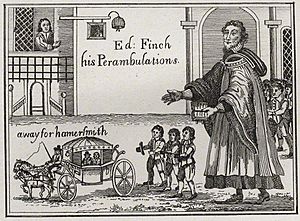Edward Finch (divine) facts for kids
Edward Finch was an English priest who lived in the 1600s. He was active between 1630 and 1641. He supported the King during a time of big changes in England.
About Edward Finch
Edward Finch was the younger son of Sir Henry Finch. His brother was John Finch, who later became Lord Finch of Fordwich.
In 1630, Edward Finch became the vicar of Christ Church in Newgate, London. A vicar is a type of priest who leads a local church.
Challenges and Changes
During the 1640s, there were many disagreements in England. These were about how the church should be run and who should have power. Edward Finch was known for supporting the King's side.
Because of these disagreements, a special committee decided that Edward Finch was not suitable to continue his work as a priest. In 1641, the Parliament made a decision that he could no longer hold his church position.
Some of the reasons for this decision were related to his religious practices. For example, he was accused of arranging the communion table in a certain way, like an altar. He also preached while wearing a surplice, which is a white robe worn by priests. These practices were seen as controversial by some people at the time.
Edward Finch passed away shortly after he lost his position. A new priest took over his church role in 1642.
His Writings
Edward Finch wrote a book called An Answer to the Articles. It was published in London in 1641. He wrote this book to respond to a pamphlet that had been published against him. This pamphlet was titled The Petition and Articles . . . exhibited in Parliament against Edward Finch, Vicar of Christ's Church, London, and brother to Sir J. Finch, late Lord Keeper.
The pamphlet that criticized Finch included a picture of him. It also had a picture showing him traveling to Hammersmith with some people. Finch explained in his defense that one of the people in the group was his sister.


